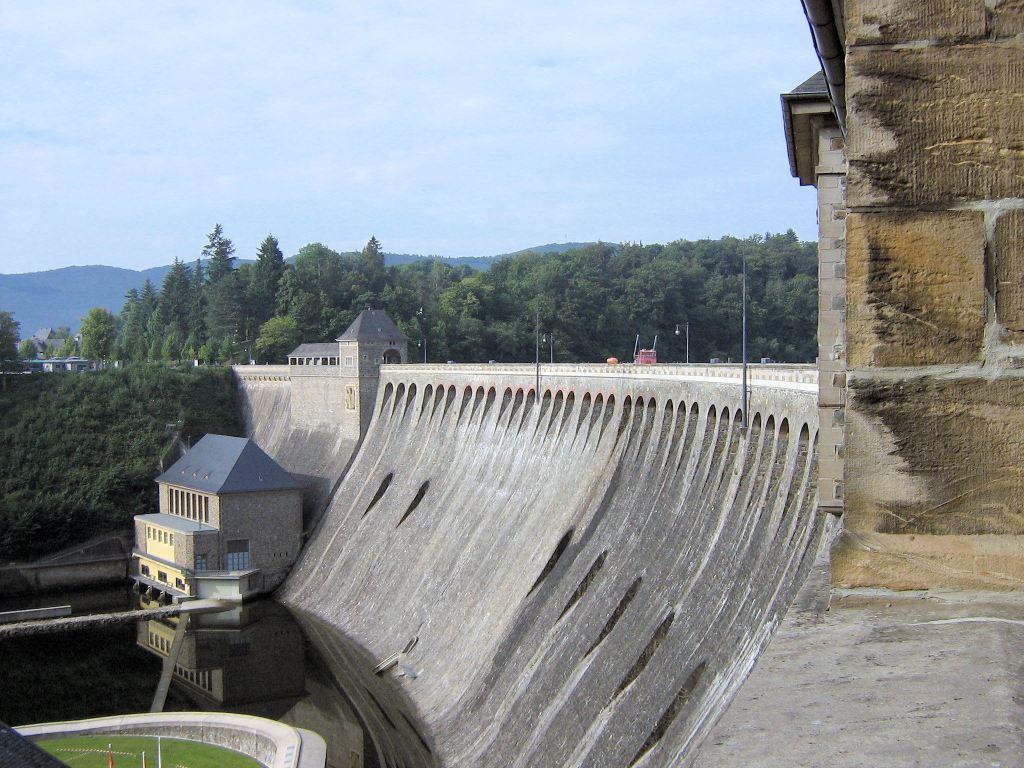Measurements in dam engineering are orientated to the requirements of three basic dam types:
- Earth dams
- Gravity dams
- Arch dams
This is well illustrated by the forces that are transferred into the foundation. With dumped dams the forces under the dam and in the abutments are very small. With gravity dams, on the other hand, the forces arising under the foundation joint are very considerable, while arched dams are affected mainly by forces in the abutments. There are also notable differences in the displacements arising in the foundation and at the dam itself, as well as in the seepage water both in and under the dam body. The measurement tasks differ accordingly.
In the case of a dumped earth-fill dam, the most interesting questions are naturally to do with earthworks engineering, for example:
- Settling characteristics of the various sectors (including the horizontal dimension of these settlements)
- The achieved degree of compaction or consolidation (partly checked during construction, partly derived from the settling characteristic)
- Deformations of the impervious core
- Porewater pressure, especially in the impervious core
- Seepage current and seepage quantities (preferably for separate zones of the dam body)
- Absorption of expansion pressure by the foundation and any yielding and displacement movements of the dam body on the foundation.
Monitoring measurements in the foundation are concerned primarily with
- Underseepage and by-seepage of the dam body or its impervious elements (impervious shield, impervious blanket)
- The level of fissure water pressure in the valley flanks surrounding the dam and in the area of known or suspected bank movements at the reservoir, which is important due to its effect on the stability of these areas
- Movements of these valley flanks or banks (creeping or sliding movements)
Geomechanical measurement activities during the construction of gravity dams are concentrated mainly on the interaction between the dam's wall and foundation. Vertical displacements of the individual wall blocks can be monitored by
- Levelling measurements
- Tube level measurements
- Extensometers or sliding micrometers set vertically in boreholes
- Horizontally arranged deflectometer chains or inclinometers
For the relative comparison of horizontal displacements in individual dam sections, the following equipment is used:
- Pendulums (in large boreholes they are extended down into the foundation)
- Vertically arranged deflectometer chains or inclinometers
- Horizontal or slightly inclined extensometers or sliding micrometers
- Geodetic triangulation of the dam foot and dam crown (here the possible degree of accuracy is at least one order of magnitude lower)
Clinometers are used to monitor tilting movements and direct-reading fissurometers are used to monitor shifts, displacements or sliding movements along fissures, faults, etc. These measurements of displacement and movement must be supplemented by monitoring and measuring of rock water behaviour, including
- Seepage loss measurements
- Monitoring of erosion
- Measurement of fissure water pressure
With a view to statics, it is particularly important to measure fissure water pressure in the foundation because it is decisive for bearing pressures, shield pressure and uplift effects. To take these measurements, all the instruments need to be positioned as far as possible at major fissures. The following instruments are available:
- Piezometers with continuous perforation, used to measure the surface level in the piezometer borehole
- Piezometers that measure in sections, where the sections are separated by packers (type Casagrande)
- Foundation water pressure transducers that are mounted in boreholes or on the contact surface directly at the fissures
Measurement activities during the construction of arch dams should be concentrated on checking movements in the bearing rock areas, particularly in the central vertical area of the abutments (Fig. 1). The concrete arch is pressed by the build-up of water into the rock bed, while the latter's deformations push the arch toward the valley. When the water level drops, the dam/rock system springs back. The return movements do not follow the same paths and of course do not reach the full extent as the forward movements.

Fig. 1 Proposal for measuring displacements in the abutment of an arch dam
a) Tension and shear loading of the abutment: Z = tension, S = shear, H = lift up
b) Measuring setup for assessing the load bearing capacity of the abutment: E = extensometer, Q = lateral displacement indicator, P = pendulum, T = access tunnel (from Müller and Fecker, 1992)
Extensometers are generally the main instruments used for these displacement measurements. Apart from extensometers, horizontal displacement components are also monitored with great accuracy by pendulum, albeit at just a few select locations. Vertical displacement components can also be measured with all desirable accuracy by tube levels as well as by taking levelling measurements and using vertical extensometers.
What was said about the monitoring of gravity dams applies similarly to monitoring of the rock water regime.
The detailed description of Geotechnical Measurements on Dams can be downloaded here as pdf.

